Mohammad Tanvir Hossain –
World War I, also known as the Great War, was an international struggle that engulfed more than 100 nations in the world, including the majority of European countries, between 1914 and 1918. The war was fought between the Allies or Entente Powers (primarily France, Great Britain, Russia, Italy, and, from 1917, the United States) and the Central Powers (primarily Germany, Austria-Hungary, Bulgaria, and the Ottoman Empire). Officially, Germany was mostly to blame for the war’s four years of unimaginable carnage. But several complex reasons, including a gruesome assassination, contributed to the war.
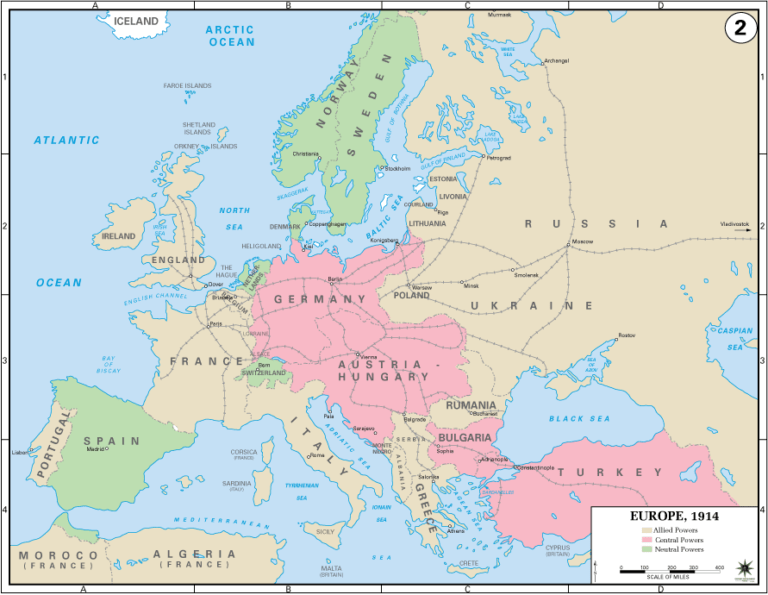
Truly a Global War
More than 100 nations were involved in this war, which makes it truly a World War. Millions of soldiers were mobilized by some nations, who fought valiantly for more than four years. Other nations were utilized as stores of supplies and labor by their colonial overlords, while still others later declared war and offered merely moral support.
The majority of the World War I were fought in Europe, where most of the nation’s citizens took part whether they wanted to or not. Around 1.5 crores of Russian, 70 lacs of British, 80 lacs of French, and 50 lacs of Italian citizens were called upon to serve in the war. On the other side, 1.3 crores of German, 78 lacs of Austro-Hungarian, 12 lacs of Bulgarians, and 26 lacs of Ottoman (Turk) civilians served in the army.
The United States enlisted 40 lacs of troops for the Allies when they eventually joined the war in 1917. Canada, a dominion of the UK, provided 4 lac enlisted soldiers and, like the US, produced weapons, aircraft, and ships.
Brazil was the only sovereign South American nation to declare war in World War I, joining the Allies. Other South and Latin American governments oscillated between neutrality and involvement in the conflict.
Australia, a British colony, contributed 3.3 lac soldiers to support the Allies in the Middle East and Germany.
India, a British colony, participated in World War I by deploying 13 lac soldiers and laborers. Despite being formally neutral, China gave the Allied forces 2 lac workers to repair tanks. Japan provided support for British ships in the Mediterranean Sea by sending 14 destroyers and a flagship cruiser. Up until mid-1917, Siam remained neutral but later supplied 1,300 troops as pilots, aircraft mechanics, automobile drivers and mechanics, and medical and support staff.
90 percent of the African continent was a colony of European powers in 1914, hence much of Africa’s participation in the war was forced or conscripted. Only independent Ethiopia and the four little Spanish territories of Rio de Oro (Spanish Sahara), Rio Muni, Ifni, and Spanish Morocco remained neutral in Africa.
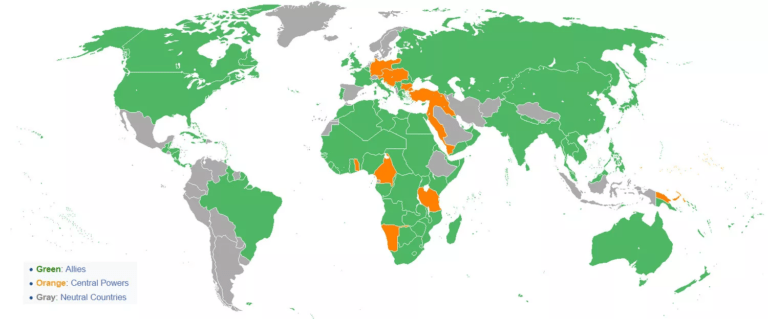
Colonial Rivalries: The Origin of Triple Alliance and Triple Entente
With the industrial revolutions in Europe, all the imperial nations were looking for new markets and imperial expansions accelerated, especially in Africa, from 1870 onwards, which led to strained relations and rivalries among the nations. All the European powers except Russia and Austria-Hungary had colonies in Africa.
The massive colonization by Britain and France fueled competition with Germany and Italy, which had joined the race of acquiring colonies quite late and only had a small portion of Africa. Thus, there were numerous clashes among Britain, France, Germany, and Italy. For example, France rivaled Italy over Tunis and Germany over Morocco. This colonial rivalry made an impact on the formation of alliances and ententes.
After losing Tunis to France, Italy teamed up with Germany and Austria-Hungary to form the “Triple Alliance” in 1882. However, Italy pledged to maintain its neutrality if Russia and Austria-Hungary went to war.
On the other side, being concerned about Germany’s expansionist activities in the Balkans and combative attitude in the first and the second Moroccan crises, Russia, Britain, and France formed the “Triple Entente” in 1907, which they upgraded with the “No Separate Peace” agreement in 4th September 1914.
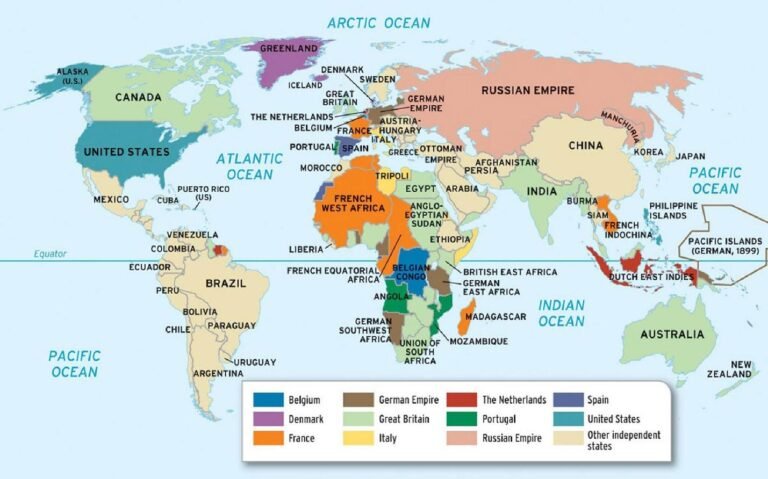
How Did the War Start?
Despite a variety of contributing factors, the assassination of Archduke Franz Ferdinand, heir to the Austro-Hungarian throne, served as the war’s primary impetus. Following the murder –
-
Austria-Hungary declared war on Serbia.
-
Russia then got ready to stand up for its ally Serbia.
-
To defend Austria-Hungary, Germany declared war on Russia.
-
To defend its ally Russia, France subsequently declared war on Germany.
-
Britain declared war on Germany after Germany invaded Belgium to reach France.
The Murder of Archduke Franz Ferdinand – Triggering Cause of WWI:
In June 1914, Archduke Franz Ferdinand and his wife Sophie traveled to Bosnia-Herzegovina province to attend military exercises. These regions had just recently been seized by Austria-Hungary, against the wishes of neighboring Serbia, which also wanted them. Bosnia-Herzegovina was formerly ruled by the Ottoman Empire, and its population was made up primarily of various ethnic groups, with around 40 percent of Serbs, 30 percent of Muslims, and 20 percent of Croats.
The couple went to Sarajevo (the capital of Bosnia-Herzegovina) On 28th June to inspect imperial troops stationed there. As they approached their destination, they nearly avoided death when Serbian militants launched a bomb at their open-topped car. Their luck quickly ran out when their driver drove past Serbian nationalist Gavrilo Princip, 19, who fatally shot Franz Ferdinand and his wife from point-blank range.
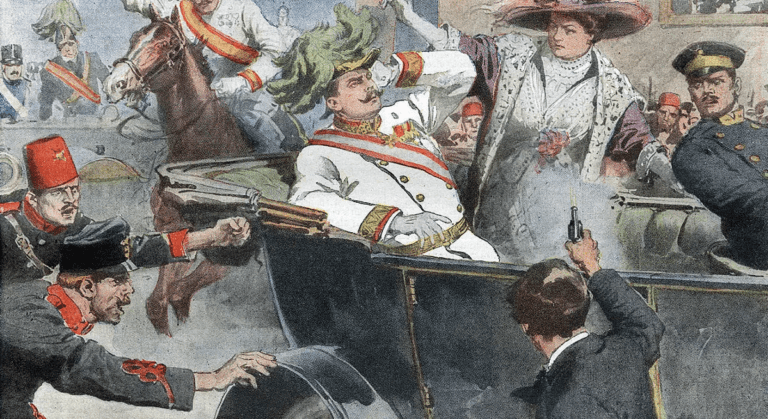
Start of the War:
The assassination was viewed by the government of Austria-Hungary as a direct assault on the nation. They thought the Serbians had assisted the Bosnian terrorists in carrying out the attack. With the support of Germany, they created an ultimatum directed at the Serbian government, which was transmitted to Serbia on 23rd July 1914, following a strategic delay.
The Serbs were given a 48-hour deadline to answer, and the ultimatum was designed to be unacceptable. It included demands for Austrian investigations inside Serbia, which would have nullified their sovereignty. Serbia then turned to its ally, its great Slavic patron, the Russian Empire. After consultations with the Russians, Serbia accepted most of the ultimatum on 25th July. At the same time, it mobilized its army to prepare for the war.
In response to an inadequate telegraph response to its ultimatum, Austria-Hungary declared war on Serbia on 28th July.
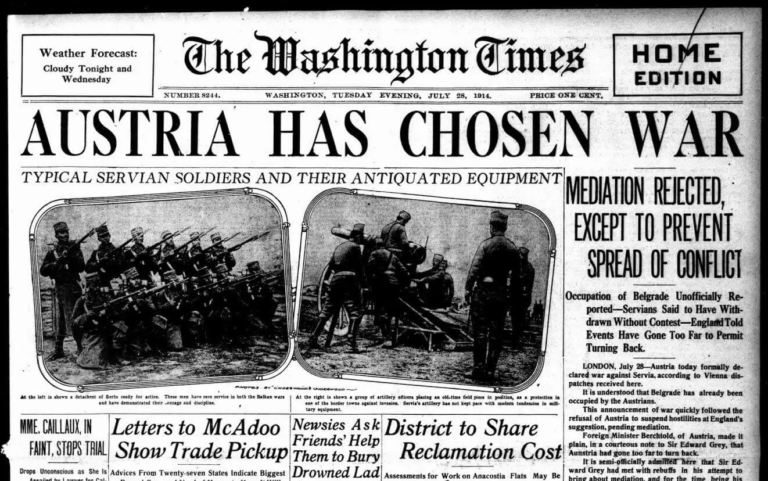
Spread of the War:
The conflict expanded way beyond a regional crisis only. Tsar Nicholas of the Russian Empire issued an order for full mobilization on 30th July. As a result, on 31st July, Germany warned Russia by giving two options – halt mobilizing or prepare for war with Germany. Additionally, it proclaimed that there was a threat of war and requested French neutrality. Germany declared war on Russia on 1st August after their ultimatum to them had expired without receiving a sufficient response.
The Schlieffen Plan, a top-secret mobilization strategy developed in 1905 to meet the threat of war, was the main German war plan. One of the key strategies was launching a quick strike on France in the west via neutral Belgium. On 2nd August, Germany issued an ultimatum to Belgium requesting that its forces be permitted to cross through.
The possibility of another Great Power conquering Belgium, which lies just over the English Channel and would serve as a prime staging area for an invasion of the British Isles prompted Britain to enter the war.
After Belgium refused the German ultimatum on 3rd August, Germany declared war on France and invaded Belgium. Having no concern with Serbia and no obligation to fight for Russia or France and committed to defending Belgium, Sir Edward Grey of Britain issued an ultimatum to Germany on the same day, and after the deadline expired at midnight, Britain joined the war on the 4th of August.
Austria-Hungary declared war against Russia on 5th August; Serbia against Germany on 6th August; Montenegro against Austria-Hungary on 7th August and against Germany on 12th August; France and Great Britain against Austria-Hungary on 10th August and on 12th August respectively; Japan against Germany on 23rd August; Austria-Hungary against Japan on 25th August and against Belgium on 28th August.
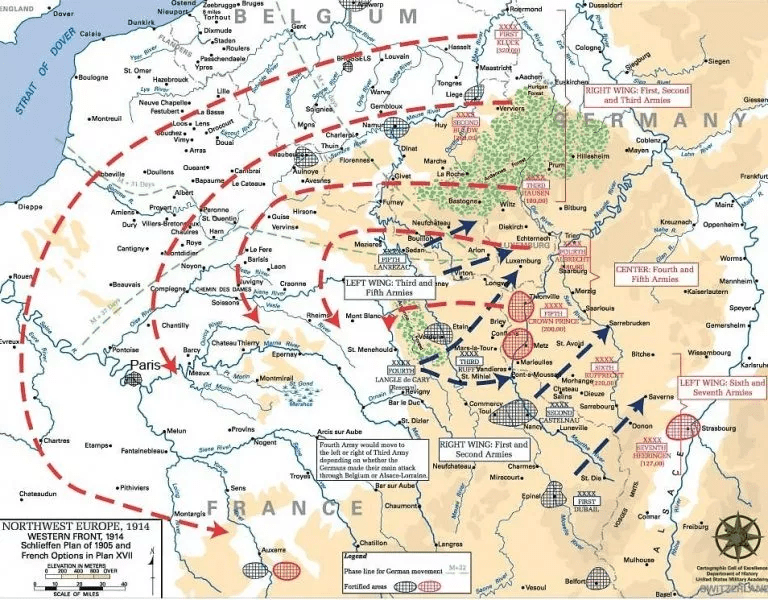
1914 Austria-Hungary Invasion of Serbia:
The Bombardment of Belgrade (Serbian capital) by Austria-Hungary from 28th to 29th July 1914 is considered the first military action of WWI. The sporadic shelling with 3 warships of the Austro-Hungarian Navy and Habsburg artillery caused widespread damage and mark the opening of the First Serbian Campaign.
On 12th August 1914, Austria-Hungary launched an assault on Serbia from across its western border. The attackers made little progress while fighting in the mountains, and a Serbian counterattack pushed them away.
Following this triumph Serbia crossed the Danube River into Austria-Hungary on 6th September, sparking the second, and more successful, Austro-Hungarian invasion the following day. The Serbs were unable to maintain the border, so they ceased the advance and withdrew to a more solid defensive position.
On 6th November, Austria-Hungary launched its third invasion of Serbia as the Serbs staged a fighting retreat to a line, close to their supplies. Both sides were slowed by snow and heavy rain. On 3rd December, Serbs launched a counterattack which forced the Austro-Hungarians to move out on 9th December.
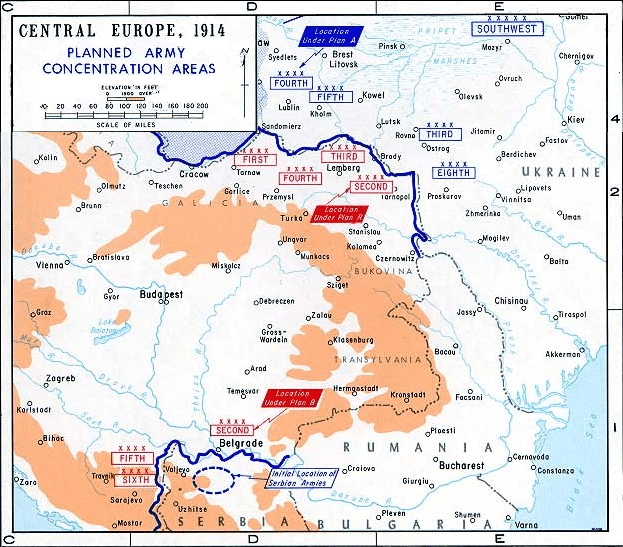
Battle of the Frontiers (4th August to 6th September 1914):
Battle of the Frontiers is the collective name for the first great clashes on the Western Front of WWI. It included the early conflicts in southern Belgium and along France’s eastern boundary, which led to a succession of startling German triumphs and Allied force retreats.
It started when German troops, following the Schlieffen Plan, crossed the border into Belgium on the morning of 4th August 1914 and occupied the town of Liège itself by 6th August and the citadel by 7th August. However, the surrounding forts resisted obstinately until the Germans used their powerful howitzers against them on 12th August. These 420-millimeter siege guns proved to be too powerful for the forts, and they fell one by one.
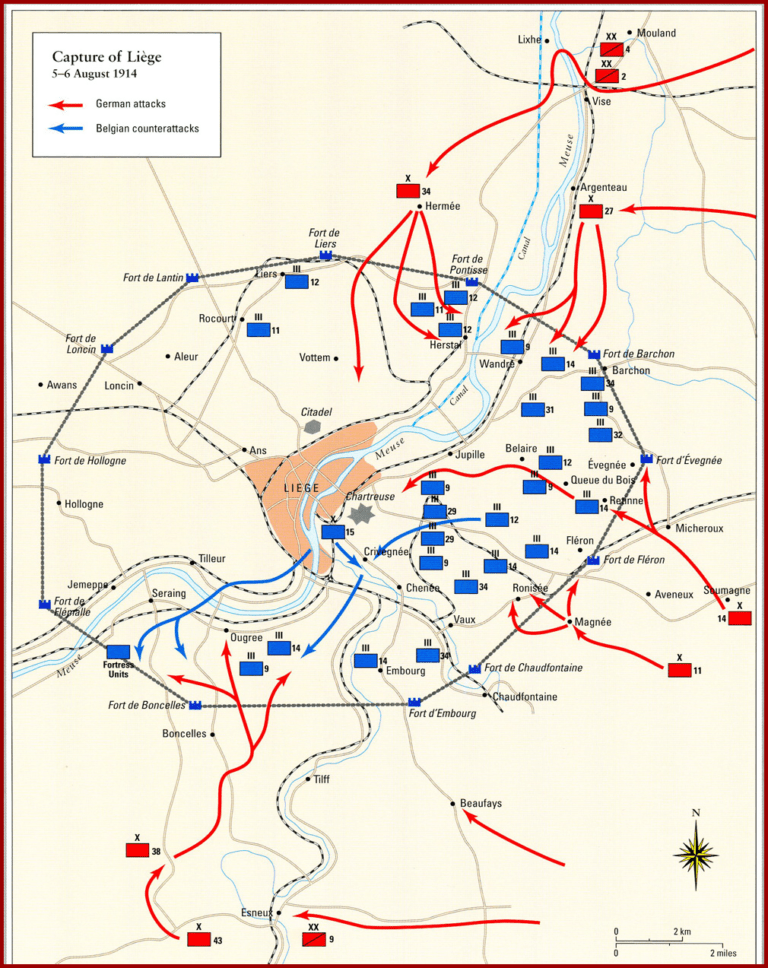
After the fall of the last Liège fort on 16th August, the Germans started pressuring the Belgian field army between the Gete River and Brussels. The Belgians then made their way north to the stronghold of Antwerp. On 20th August, the German first Army entered Brussels while the second Army appeared before Namur, and the others remained in the fortress to block the Meuse route into France.
The French Army and the British Expeditionary Force suffered a catastrophic defeat at the Battle of the Frontiers. As per the Schlieffen Plan, the German Army was able to drive back the main French and British forces and move its troops into French territory as it pushed towards the French capital, Paris.
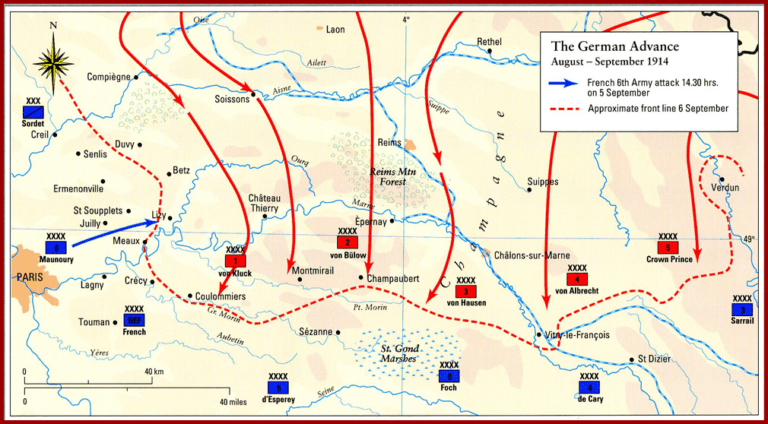
The First Battle of the Marne (6th to 12th September 1914):
The First Battle of the Marne marked the limit of Germany’s initial advance into France. Utilizing the Schlieffen Plan, German soldiers swept through Belgium and into France from the north. A gap developed between the two armies on the German right-wing despite pushing back French and British troops. Taking advantage of this, The Allies attacked into the opening and posed a danger to envelop the German First and Second Armies.
The Germans were compelled by this to stop their advance and withdraw behind the Aisne River. The battle, known as the “Miracle of the Marne”, prevented a swift German triumph in the west, and saved Paris.
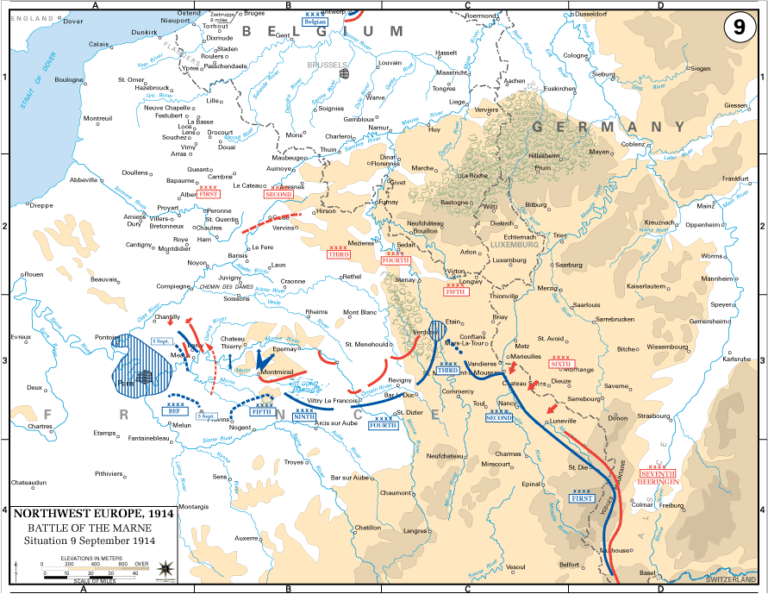
Race to the Sea (September and October 1914):
After Germany failed to seize Paris, both parties raced north to gain advantages over the other. Throughout September and October, British and French forces resisted the German advance up north until on 19th October the two sides met at the North Sea in Belgium. Both parties engaged in several small battles during the Race to the Sea, although neither side emerged victorious.
This race resulted in a line of trenches that covered much of northern France and Belgium. Some of the major events of WWI occurred along this line of trenches. This was given the name Western Front.
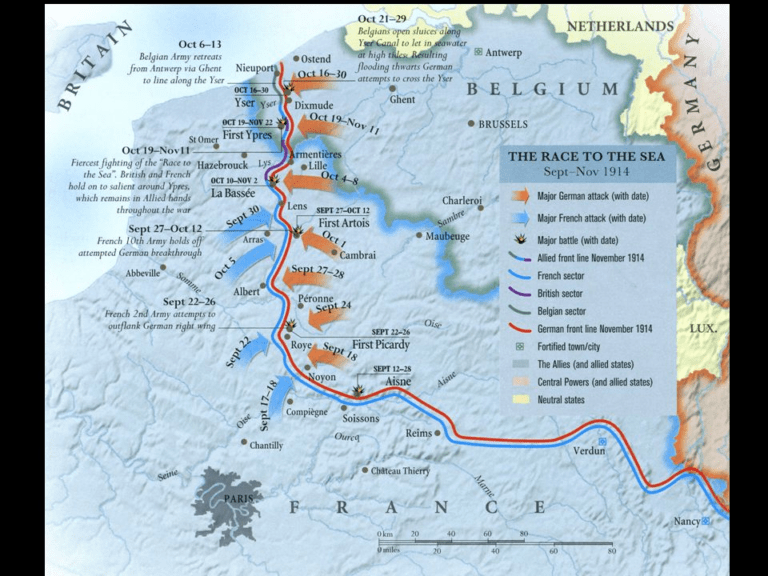
Trench Warfare in WWI:
Building deep trenches on both sides of the battlefield as a kind of defense against the enemy is known as trench warfare. It was used on the French western front during WWI. Both sides had created a network of trenches that stretched from the North Sea to Belgium and France by the end of 1914. As a result, over the three and a half years from October 1914 to March 1918, neither side gained much ground.
The standard trench was dug into the ground around twelve feet deep. At the top of the trench, there was frequently an embankment and a barbed wire fence. Sandbags or wood beams were used in some ditches as reinforcement. Typically, wooden duckboards were used to cover the trench’s bottom to keep the soldiers’ feet out of the water that would pool at the bottom.
The trenches were not constructed in a single, uninterrupted line, but rather as a network of interconnected trenches. There were numerous layers of trenches along the lines, and passageways had been created so that men could move between them. They were dug in a zigzag fashion.
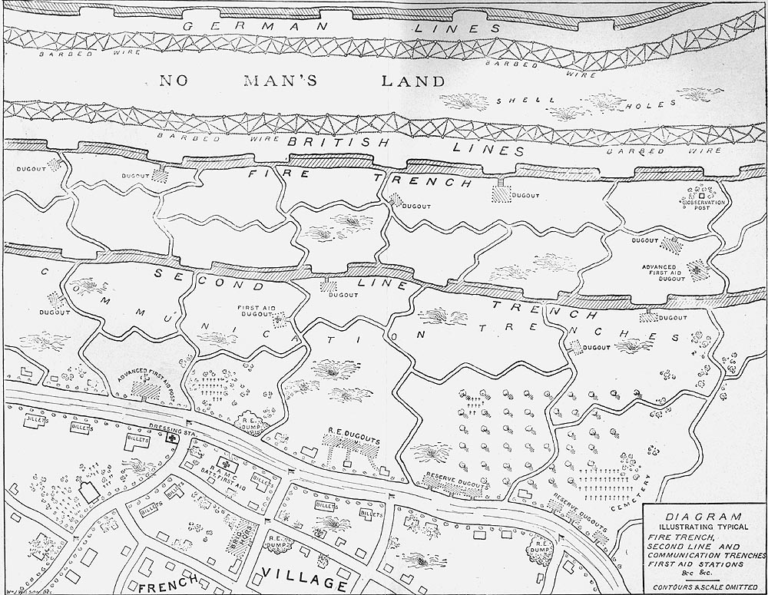
The First Battle of Ypres (19th October to 22nd November 1914):
Following the conclusion of the Race to the Sea, the British, Belgian, and French forces fought against the German forces near the town of Ypres, which is located in western Belgium. Both sides adopted trench warfare, and this conflict proved disastrous for all of the parties and left no clear victor. This became a recurring theme throughout the numerous significant battles on the Western Front.
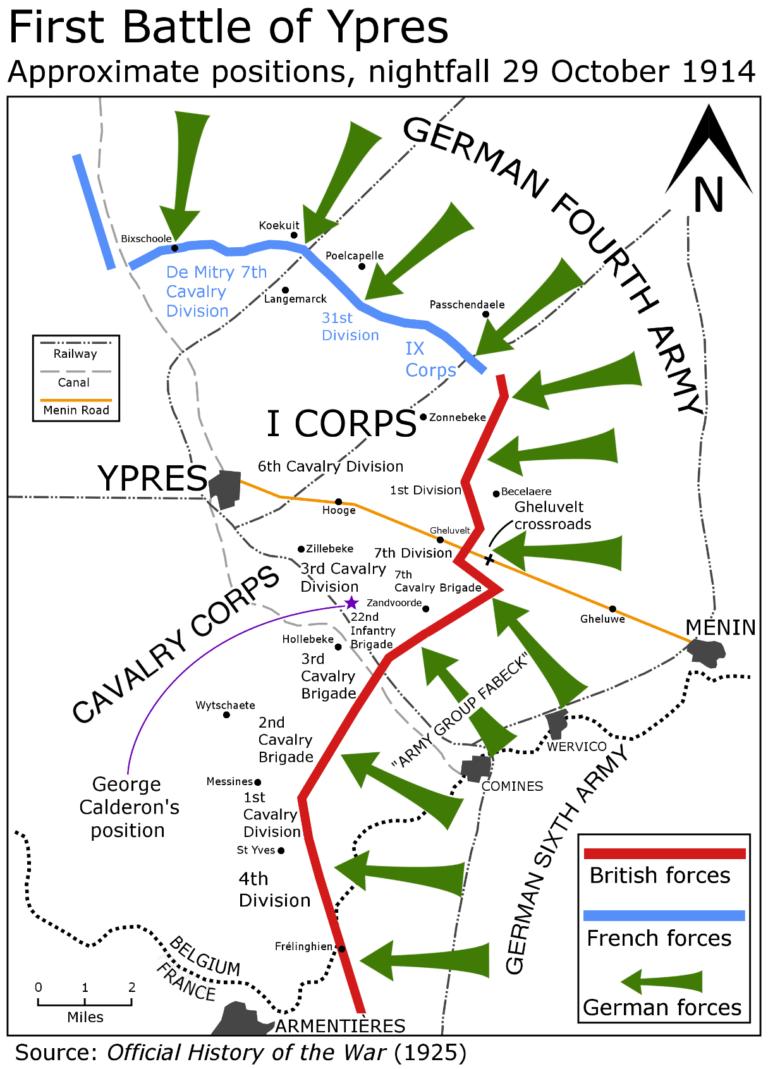
The Situation on the Eastern Front:
As per Schlieffen Plan, only Eighth Army was allotted to the defense of East Prussia since it was anticipated that the Russians would need many weeks to mobilize and convey their forces to the front. While this was largely true, two-fifths of Russia’s peacetime army was located around Warsaw in Russian Poland, making it immediately available for action. While the majority of this force was to be directed south against Austria-Hungary, the First and Second Armies were dispatched north to invade East Prussia.
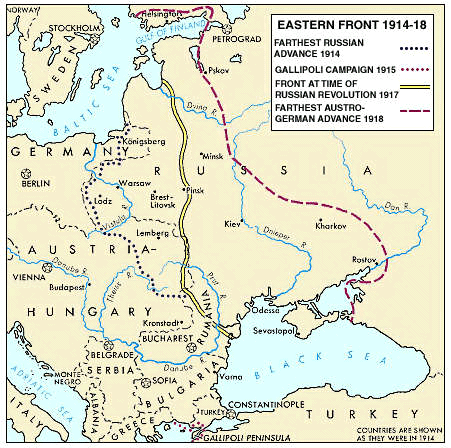
The Battle of Tannenberg (23rd to 31st August 1914):
The Battle of Tannenberg saw German forces in the east easily destroy Russian Second Army with the utilization of signals intelligence, knowledge of the enemy commander’s personalities, and effective rail transportation.
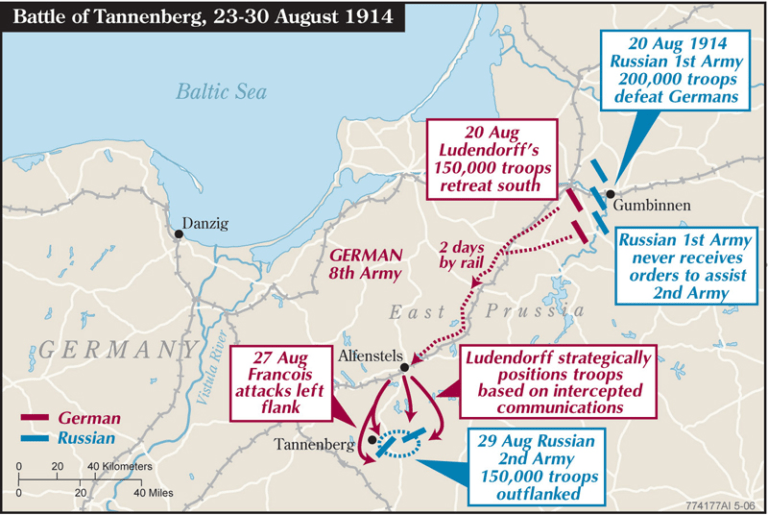
The First Battle of the Masurian Lakes (9th to 14th September 1914):
The German offense in the Masurian Lakes forced the Russian First Army completely out of Germany in disorder. However, the advent of the Russian Tenth Army on the left flank of the Germans impeded further advancement. This conflict disrupted Russian plans throughout the spring of 1915 even though it was not as destructive as the Battle of Tannenberg.
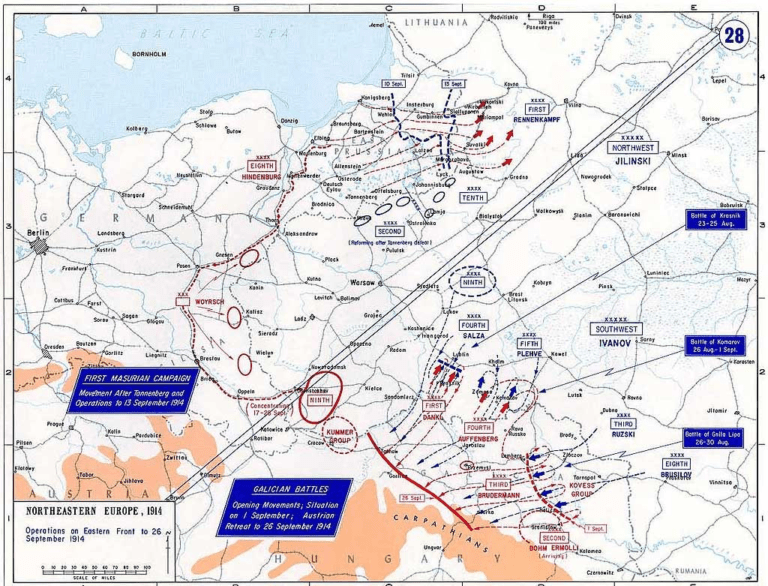
The Battle of Galicia (2nd August to 11th September 1914):
The Battle of Galicia, fought between the Austro-Hungarian and Russian forces, was one of the most significant battles of WWI along the Eastern Front. The armies fought against one another in a series of smaller conflicts, including the Battle of Kraśnik, the Battle of Komarów, the Battle of Gnila Lipa, and the Battle of Rawa. The Battle of Galicia resulted in a significant Russian triumph on the Eastern Front capturing significant amounts of territory around the city of Lemberg.
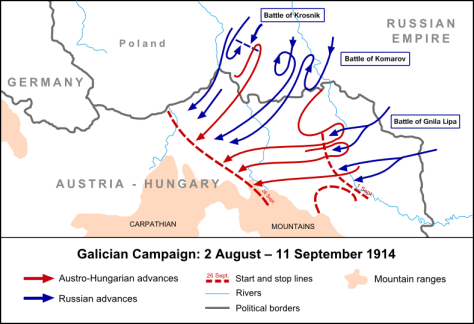
The First Battle of Warsaw (28th September to 30th October 1914):
As the Austrian position deteriorated, they requested assistance from the Germans. Germany then moved the newly formed Ninth Army forward to Warsaw to relieve strain on the Galician front. On 9th October, they were halted at the Vistula River by the Russian Northwest Front and compelled to fall back.
The Battle of Lodz (11th to 23rd November 1914):
The Russians next planned an offense into Silesia but were blocked by the Germans with a double envelopment. However, German operations failed in the ensuing Battle of Lodz and the Russians came close to winning.
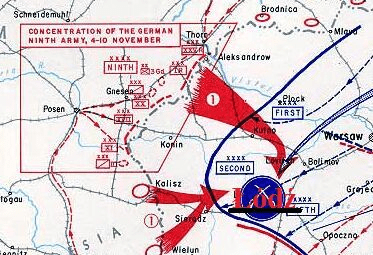
The Christmas Truce of 1914:
The 1914 Christmas Truce occurred from 24th to 25th December (in some places up to 1st January). Although not officially sanctioned by the high command, several unofficial ceasefires took place during which troops from opposing sides joined forces to rejoice and partake in sporting activities.
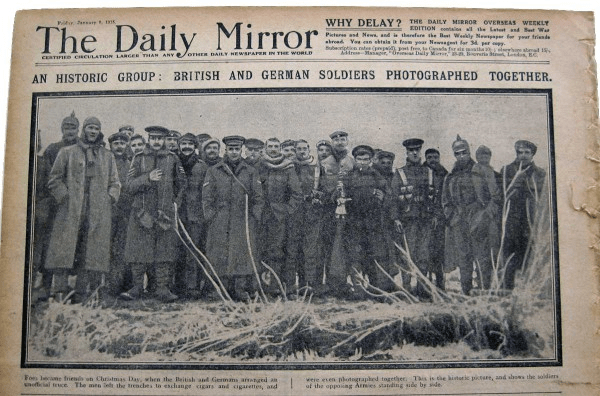



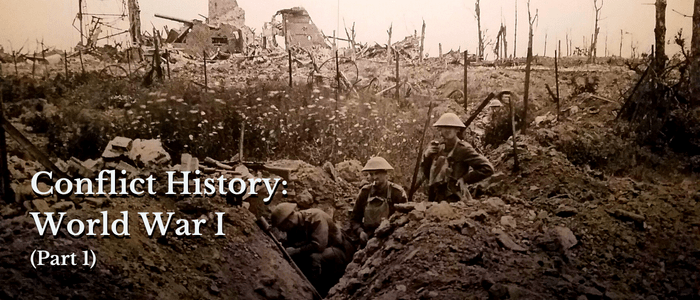
Great informative article. Well written 👌👌👌
Informative and easy understanding, thanks for this nice write-up!